Tobacco Rowed
Windsor (Google Maps Location)
April 7, 2007
2018 Update: Oof. I cringe at these super old pages… anyway, this page used to combine the tobacco museum, now named the Connecticut Valley Tobacco Museum, and the Northwest Park Nature Center. I’ve separated the two which makes for a somewhat clunky page.
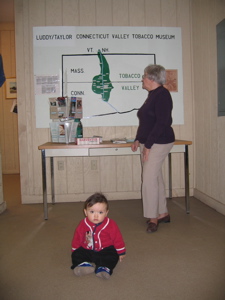
CTMQ (né Connecticut MuseumQuest) co-founder EdHill moved to Washington DC in mid-March 2007. I vowed to continue the quest despite this rather consequential blow. I would drag my family and other friends along with me to spread the fun of learning about Connecticut history and miscellanea. Then a funny thing happened; EdHill insisted on making museum visits with me as much as he could. He was/is so dedicated, in fact, that he drove the 350 miles or so on Easter weekend in order to learn about the rich history of tobacco farming in the fertile Connecticut River valley at the Luddy/Taylor Museum in Windsor! EdHill, in a word, rules.
Luckily for him – because he really wanted to hit this particular museum. Seriously, after I soloed the Edward E. King Museum of Tobacco and Aviation, he mentioned that he wanted to be sure to see another tobacco museum in the state.
And so here we are – Damian and I, just a few weeks later back at Northwest Park in Windsor.
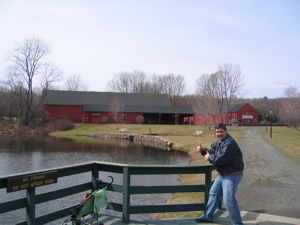
Ok, let’s learn about tobacco farming! We were once again greeted by the same sweet curator who seemed quite eager to give us the tour. She didn’t care that we had a one year old with us; we were going to get the full explanation no matter what. One is never too young to learn about the rich history of Connecticut’s relationship with shade tobacco, right?
Right. The woman’s name was Marian Nielsen and she was wonderful. The Luddy/Taylor Museum was more or less hers to run and keep up, and her pride was evident at every display. The one room museum area had multiple displays tracing tobacco farming from colonial days through today. Way back in the colonial days, farmers here grew nasty ol’ broadleaf tobacco plants, which was fine for smoking back then I guess. Then one day, someone noticed the plants grown on Sumatra were much nicer so they planted those seeds in the fertile CT River Valley.
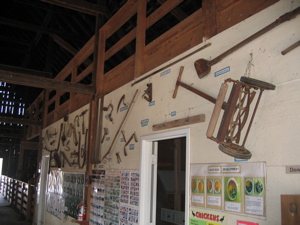
When they grew, the leaves got sunburnt and thick and veiny and the tobacco wasn’t good at all. Hmmm, what to do. Someone thought to cover the plants in cotton cheesecloth after noticing the growing season in Sumatra was cloudy. Voila! Not only did the covering protect the plants, but it raised the humidity under the tent and kept out bugs – basically mimicking Sumatra without the pests. The plants grew beautifully and the leaves were supple and perfect.
The Connecticut shade tobacco industry was born on River Road in the Poquonock section of Windsor. John Luddy made a fortune selling the cheesecloth for the tobacco farms and even got a museum partially named after him. A museum that EdHill, Damian, and I were enjoying very much. Who knew there was so much to learn about tobacco farming?
2022: It’s weird reading these old pages now. There are 10 tobacco-focused museums in the area. My son is now 16 and Ed has passed away. There are a few tobacco barns left on River Road, but Amazon now has a huge facility there.
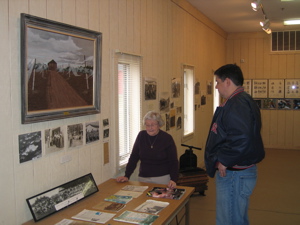
The rich valley initially stretched from Portland, CT up to Brattleboro, VT, but over time the size has diminished greatly. The process to grow this stuff is very costly (about $30,000 per acre) and labor intensive. And yet, even today, CT shade is still considered the finest wrap tobacco in the world, fetching up to 4 times more money than the next best type. Today in Connecticut there are still about 2000 acres of tobacco farmland left – as any visitor who flies into Bradley Airport can tell you. All around the airport in Windsor Locks the signature billowing white tenting can be seen from high above during late summers (it’s synthetic today, but the principle remains).
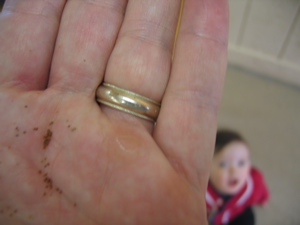
Those are tobacco seeds which grow to be 12 foot tall weeds in just a few months. And that’s an amazed little kid below, which grow to be 6 feet tall in about 16 years. [Note: this didn’t turn out to be true.]
While Ms. Nielsen schooled Ed on the various immigrant and child labor classes that have come and gone to work the CT fields, I tried to occupy and entertain Damian. He was being very good and took to reading some magazines – and what one year old doesn’t enjoy a nice issue of “Cigar Aficionado?”
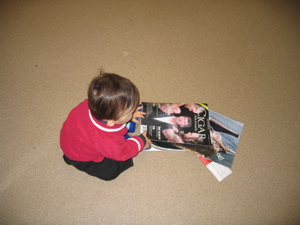
None that I know of, that’s for sure:
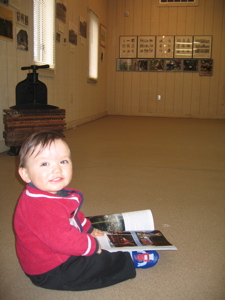
We all learned about the incredibly tedious process of tobacco farm tenting. The plants themselves are incredibly easy to grow – tobacco is a weed. The seeds are nearly microscopic and the rate of growth is simply amazing. These plants can grow up to 4 inches a day when conditions are right – they go from an inch or two high to 10 feet in a matter of 3 months or so. The tents are still put up by men, and each individual plant is still tied up by men. They must be spaced perfectly and protected from everything from hail to bugs to sunlight to dryness to people touching the leaves.
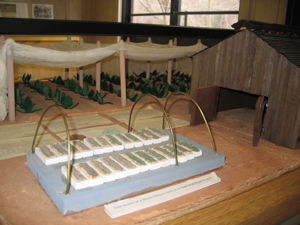
The museum’s model of a tobacco field and barn…

…Which is kind of silly when the real thing is on the road to the museum.
I can’t think of a much worse job in the world to be honest with you. Marian went on to explain more about the harvesting and the evolution of the implements used to do so. I tuned out at this point and wandered off with Damian for a little while. I found a little anteroom which housed the Francis M. Lutwinas Memorial Book Collection. Apparently this Lutwinas character really enjoyed books about tobacco, because that’s all that was there. Geeze, talk about a specialized interest.
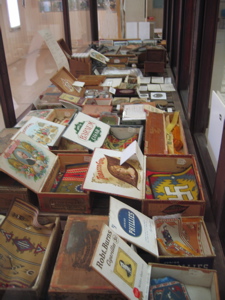
Does anyone want to play ‘Spot the Nazi memoribilia?”
In the same room was a little TV and VCR set up. We could have watched a 30 minute video about the Windsor area’s tobacco farming. No thanks, I think Marian is doing a mighty fine job of it. Hmmm, I wondered what Ed was up to out there? (I could still hear the tour fine, mind you.) “Gordon Taylor ran the Agricultural Experiment station in town and in his retirement helped to prepare the displays at the museum which opened to the public in 1992,” Marian was explaining. Ah, so now we’ve learned the second identity of the Museum’s namesakes. Good, that question was eating me up – and I know you as well.
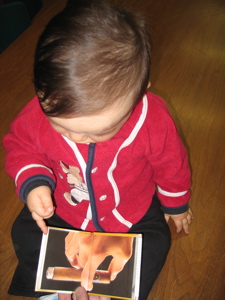
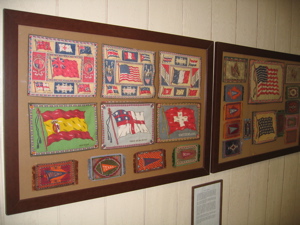
Tobacco flannels
There was a display of so-called tobacco flannels in the little library room, which were put in cigar boxes 100 years ago or so to lure more woman buyers. It wasn’t until later that tobacco companies learned that children is where the real money is I suppose. Speaking of kids, Damian was getting fidgety so we returned to the tour and enjoyed an old humidifier, as well as some old cigar rolling tools which Marian described as, “I have no idea how these things work.” That’s fair, a person can’t know everything!
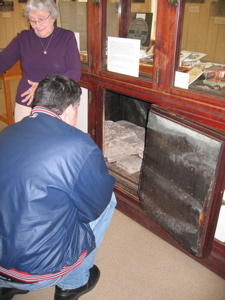
As we wrapped up the first part of the tour, we learned some of the cigar brands that use CT shade tobacco today. I wouldn’t know one from the other, of course, but I’m sure it’s an impressive list. “The best in the world,” we were told again. Which reminds me… Anyone who thinks for some reason that Cuban cigars are somehow better than say, Dominican cigars is nothing more than a sucker for the cache of the illicit nature of Cubans. They are grown in the same exact climate on the same exact soil type people! And besides, the good Dominicans use CT shade, so stick with what’s legal anyway.
We made our way over to the drying barn which was filled with old and new farming tools and machines. The Luddy/Taylor Museum is very well put together and much, much more varied and interesting than I’d ever thought. Marian showed us how the barn had side flaps built into it that allowed a breeze to help dry the tobacco leaves – a pretty cool trick I thought.
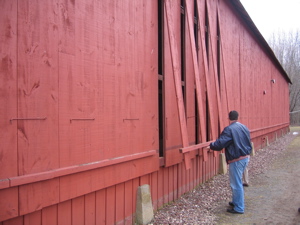
Flap on! Flap off!
There’s only so much that can be said about old farm equipment so we quickly made our way through the barn. Not that it wasn’t impressive – it was! But it wasn’t heated and Damian was starting to get a little fussy at this point. And what do we do with Fussy Gussies? Why, we pull them in sleds and call them Li’l Wacky Tobacky, that’s what:
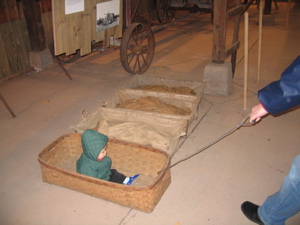
Wacky Tobacky!
The shed had some real tobacco drying but it was from last summer. In other words, it crumbled at a touch, but it was neat to see the process and to learn that a working shed would be filled floor-to-ceiling with the giant drying leaves. The best part of the barn section was when Ed’s brother text messaged him asking about his whereabouts. Because, y’know, he lives in DC now and was up to see ostensibly see the family and all. “Where are you?” asked Kevin. “At the tobacco museum,” Ed texted in reply. This, of course, caused Kevin to reply, “LOSERS,” and that was that. Am I the only one who detects a hint of jealousy? After all, this was highly fascinating stuff, just look at Ed learning about some rickety old tractor thing:
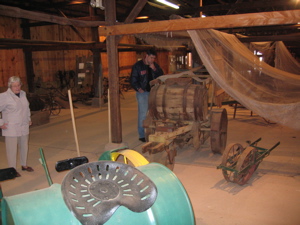
Don’t believe me? Using the latest technology, I zoomed in on Ed which shows just how fascinated he was:
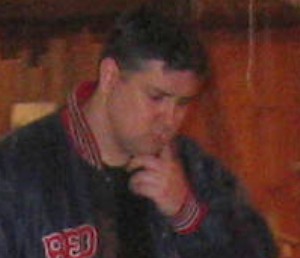
Once done, it was almost as if Marian didn’t want us to leave. I will never not appreciate how much these museum-folk care about their collections and thrive on passing their knowledge along. That left only one question: So Marian, do you smoke? “Nope, never in my life.” That’s nice, but unfortunately, she did such a good job and her tour was so informative and entertaining that she convinced one participant of the smooth pleasurable enjoyment of a a nice Macanudo:
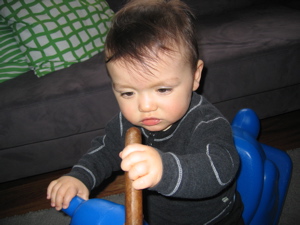
Please note, no children were harmed in any way in the taking of this picture.
CT Valley Tobacco Museum
Northwest Park in Windsor
CTMQ’s Museum Visits

 stan pelletier says
stan pelletier says
February 11, 2008 at 9:31 ami grew up in south windsor, connecticut. i remember the tobacco fields well. they were my playground for many years. the fields were owned by the consolidated cigar corporation. in the summer, workers would be brought up from puerto rico and from west virginia. about half a mile from my house was a barracks for the west virginia boys. i would hang out with them throughout the summer and the cooks would often feed me and give me free coca colas. adjacent to almost every field would be a tobacco barn. when i turned fourteen i was deemed old enough to would in the fields. i remember scooting through the dirt rows on my butt rubbing suckers off the plants. suckers were small buds growing from the main leaves and the stalks and hinder the growth of the main leaves. i remember picking the lowest and biggest leaves and placing them in the baskets which were then taken to the barns. i remember the large reservoir used to irrigate the fields, it had an island in the middle, my friends and i would skinny dip in the reservoir and built a raft to get out to the island, there were lots of turtles and frogs. the thing i remember most is how the tenting looked like snow, for miles and miles, during the 60’s and 70s. by the 1980’s tobacco field lay barren, then sold to developers for housing devolments. i left connecticut in 1972 and havent been back much since.
 wolfson says
wolfson says
October 4, 2008 at 5:20 pmwhen i was 14 i was recruited from mediera beach juinor high (fl.) to pick tobacco in simsbury con. we stayed at an old nike missile camp.we we were paid 1.05 per hour , or 10cents a bent. we paid 14 dollars per week for room and board . we took field trips to many places close to our camp. we would go to a shopping plaza every thursday(maybe it was wednesday).sometimes it would be the mall in hartford.this was in 1969. i also went in 1970 and 1971. in 1971 i saved over $650. i used this money to buy a 1967 chevelle super sport in my junior year in high school. some of us could pick between 150 and 200 bents per day. we would run from the end of one row to the front of the next row because we could make more on piece work. some kids would fool around in the fields. they would pole pirche ,walk on the netting over the fields, tie string to rock,tie the string to the next leaf to be picked so when the leaf was picked the rock would hit the picker. there were many other antics.
 Alfredo Santos says
Alfredo Santos says
November 14, 2008 at 8:04 pmFor a couple summers in my youth (back in the late 50s/early 60s while attending Ludlow High School in Ludlow,MA… I used to work at farms owned by Hathaway-Stein Tabacco Company… back bracking work under that cheesecloth netting but memories…. awwwww…. Probably by today’s standards that would be considered child abuse!
Good memories!
alf
 Scott Graves says
Scott Graves says
January 17, 2009 at 2:42 pmI was also a student at Madeira Beach jr. high in 1970 and went up to pick tobbacco in Conn. A teacher named Ben Szaro took a group of kids up there every summer. In the fairly small town of Seminole Florida many of the young men had been to Camp Nike to pick tobacco. It was a great adventure for us and something I will remember forever. Camp Nike was between Simsbury and Avon and as mentioned above was an old Air Force base. I drove through Simsbury in 1994 and other than an old tobacco barn on the corner I didn’t see much I remembered. I would like to visit again, this time staying longer and visiting the old site of camp Nike. I believe there is an office complex there now. I’m in my mid-50s now but still have good memories of my time as a 16 year old in the Conn. river valley.thanks- Scott Graves 6580 Seminole Blvd. #541 Seminole Fl. 33772
 Pat Batchelder says
Pat Batchelder says
March 7, 2009 at 2:07 pmI, too, went to work at Thrall Farms outside of Windsor Conn. way back in 1957 and 1958. I had heard about it from a high school friend in Tamp Fl, and took the idea to my school in Clearwater FL. The farm we lived on was beautiful. The girls lived in a barn like dormitory, with sleeping cubicles upstairs and restrooms, showers and rec room downstairs. The boys lived up the hillside over the kitchen and dining room that also served as larger rec room. This was a beautiful working farm, with crops and sheep. We even had a picturesque pond that many of us got dunked in. Two of the owners children, Cynthia Thrall and her younger brother worked with us driving the bus and tractors. Our mornings started about 5:30 and the girls got on the buses and went to the sheds where we ‘sewed’ 24 tobacco leaves on a lathe. For every bundle of lathes (48 or 50 I can’t remember) we were paid $1.00. If we did over 10 bundles in a day we got paid $1.10. The boys went on a separate bus to the fields and got paid by the hour. In the fields were migrant workers from Puerto Rico and Jamaca. The girls worked mostly with the Jamaicans. We were fascinated with their beautiful English accents and polite ways. They would bring the picked baskets of leaves into our shed and hang the strung lathes up in the rafters. We had to be very careful not to puncture the leaves as that would decrease their value. Our lunches were brought to the sheds for us. There was more food there than one could ever eat. I gained 10 pounds each summer. And I like many, developed a rash from exposure to the tobacco and Calamine Lotion became a good friend.
It was an experience I will never forget.
 Ruthann Hubbert says
Ruthann Hubbert says
May 23, 2009 at 7:11 pmMay 23, 2009
Saw this site and enjoyed reading the story about the Thrall Tobacco Farms outside of Windsor, CT.
I was among a bus load of girls from central PA who lived in the summer of 1959 in a Victorian house and worked for this same company sewing large tobacco leaves on a string. These were then tied to a lathe, that was then hung to dry. We did not work in the fields but went from barn to barn, where as sheds were filled, the P. Rican fellows would relocate the machines in the evenings to another shed and the next morning we would resume the sewing. One day when the leaves were wet from rain I could not get the stem in the clasp before the large needle severed a portion of my finger. Still have the scar.
Our headmistress at the camp house was one of my schoolteachers from Middleburg High School.
It was an enjoyable summer making friends and earning some money.
I would like to make contact with others who lived in this camp. Please feel free to make contact.
 Lori Leverett says
Lori Leverett says
July 3, 2009 at 4:41 pmI attended Camp Homestead, the Thrall’s tobacco farm for youth for nine years. 1978-1987. My mother, Earlene Andress, attended camp in 57,58,59 and my aunt, Judi Andress, attended from 1960-64. My siblings Jodi, Kim and Robert also attended for many years. You could say it was a family affair for us. We all loved it. After 2 years as a camper, I became a supervisor. I recruited in the public schools in Florida in the hopes of bringing 70 girls and 100 boys along to camp with me. Those years in camp helped to mold me into who I am today..as I went into the education business becoming a teacher and currently an assistant principal. Working at the tobacco farm taught me a work ethic..that kids today are not learning. Those were special years in my life and I enjoy remembering those times. I also enjoyed getting to know the Thrall family. When I recruited kids in Fl…one of the selling points to parents was describing the camp as a “family camp”…where all members of the Thrall family were involved. Again, camp was a wonderful experience and memory that will last a lifetime.
PS. Pat Batchelder in the previous email…I think my mother went to camp with you.
Anyone out there…let me hear from you. lori.leverett@polk-fl.net or 2027 Hoof Print Ln. Lakeland, Fl 33811
 Bill Burke says
Bill Burke says
August 31, 2009 at 6:19 pmI was 14 when I left western Pennsylvania for the Connecticut River Valley to work in the tobacco fields. My camp was very close to the Massachusets border. We had about 50 kids in camp. I was there between 1970 and 1972. Anyone with info on the camp or if it still there please contact me.
 Cathy Floyd says
Cathy Floyd says
September 27, 2009 at 2:13 pmI spent the summer before my Senior year of High School (Tampa FL) in Tarriffville CT working for Culbro Tobacco Company in the fields and sheds. A group of my high school friends joined other girls from our area for the 24 hour bus ride to CT.
Hard, hard work…but I mostly have fond memories of the time in the dorms and Sundays spent traveling to great places like NYC, Boston and Mystic Seaport. I think I made about $60.00 for the whole summer….
 Monica McGuire says
Monica McGuire says
October 11, 2009 at 2:13 pmI along with other girls from all over worked in the Connecticut Tobacco Farms for the summers of 1979, 1980 and 1981 when I was 14, 15 and 16 years old. I recall the town of Simbury. I developed the work ethic I have today sewing and picking tobacco. If you could sew more then 9 bundles of tobacco in a day you were making peace work and got extra money. I got to take home about $700.00. That was alot of money back then.
 Rick Miller says
Rick Miller says
November 20, 2009 at 7:01 pmHello All Former Tobacco Pickers/Draggers/Sewers;
I stumbled across this site by accident. I too am a “survivor” of three yrs of tobacco work, two as a kid from FL (Lakeland) in 65 & 66 at the Nike camp in Simsbury with Ben Szaro, and one year as his asst camp director when I was in college in 71 or 72. So many memories of the cold mornings and hot afternoons, picking a big ball of black tar off your hands when you got back to camp.
Does anyone know the whereabouts of Ben Szaro? He was an ex-Air Force sergeant I think, he had that short crew cut and very strict, organized, but a great guy. I also found out that the one and only Martin Luther King also picked tobacco in Simsbury in 1944 to raise $$ for college…what an honor to be included with him twenty yrs later!!
I enjoyed the girls camps dances we had, the softball games, the trips to NYC, Hartford, Boston, etc…what an experience. I think it made us all more appreciative of the work ethic and money. I have to ask Stan Pelletier, if he still reads this site, if he has a relative named Ron LeFrancois of Bristol, Conn? If so, he and I became good friends, and even correspond until this day (I live in AZ, he in DC). My second yr at camp I lucked into the best job at camp….the houseboy job !! You stayed back at camp, did the laundry on those old washers with the ringers, mopped the barracks, etc. But you were done early, and got to laze around the camp by yourself. Anyway, thanks for letting me share a wonderful part of my life. rick miller
 Shari Jabbar says
Shari Jabbar says
November 25, 2009 at 10:20 pmWe have started a group on Facebook for Camp Homestead. Anyone can join. Please post some of your pics from camp and share your memories.
 Ben G Szaro says
Ben G Szaro says
January 16, 2010 at 11:55 pmI ran across this website by accident. My father was Ben Szaro, the teacher who took kids up from Seminole to work in the summers. To Rick Miller, he passed away in October of 2003 at the age of 82. I worked with my Dad as camp houseboy when I was in high school in ’69 and ’70 at Camp Nike (Culbro Tobacco CoO and again in ’71 at the Thrall’s Camp in Windsor …yes it was a good job. During those years, I roomed at one time or another with both Wolfson brothers; I also remember Scott Graves and at least one of the Pelletiers from Windsor. In college, I returned with my Dad to the Consolidated Cigar Co’s camp in Suffield CT in ’74 to work in the fields as a supervisor…my younger brother got the houseboy job. The following year, ’75, was my Dad’s last year taking kids up. By then, my two brothers, my sister, and I had finished high school and left home, so my Mom and Dad didn’t need the money from a summer job anymore. He spent the next 15 summers touring the US with my Mom in a camper.
I liked the Northeast enough (to this day I can’t stand the summer heat in Florida) that I went to college in Massachusetts and now live not far from the Connecticut/Massachusetts border in upstate NY.
A few years back, I drove through Simsbury and Suffield, and was surprised at how much it has changed. On the way there, I passed the tobacco museum, but didn’t stop. I now wish I had; maybe next summer. The road between Simsbury and Avon, where Camp Nike was located, was unrecognizable except for the Heublein tower looming over the vallyer from Avon mountain. The road itself is now crowded with housing developments and condo villages. I ate lunch at a McDonald’s in a shopping mall in Avon,which in the 60’s was just woods. I made my best efforts to find Camp Nike, and found the road leading to the Nike missile silos, which are still there, deep underground; Camp Nike itself is now a Condo village. I also climbed the Heublein tower on top of Avon mountain, where I had gone with my Dad and some friends from the camp (Stan Stone and Charlie Cramb) on many hikes in the late ’60’s and early 70’s. The tower itself was closed back then, but is now open to the public. It’s worth the trip. Although it was mid summer when I visited, there wasn’t a sign to be seen of the cheesecloth covered fields that filled the valley in the 60’s and 70’s. I guess that’s why there is now a museum.
 jerry smith says
jerry smith says
February 21, 2010 at 2:11 amwent to conn in 1964,65,and 66. worked for culbro tobacco div.Barney Dudack was the field boss.stay in simsbury at the old buildings for one year then at the nike missle bass for two.
 Scott Graves says
Scott Graves says
February 28, 2010 at 2:45 pmChecked on the site as I do from time to time and enjoyed seeing the response from Ben Szaro Jr. I remember seeing your dad’s obit. and in fact I still have it. He died at sun city center if I remember correctly. I too tried to find old Camp Nike site in 94 but did not have the time to do proper search. Thanks for your response – you may also remember Peter Celeste and his brother Joe, Guy Poteat, Daryl Robinson and other Seminole vets of Nike experience. Thanks to your dad for giving us all that adventure. Scott Graves Egretkey@earthlink.net
 shirley ottaviani hnottavange says
shirley ottaviani hnottavange says
March 20, 2010 at 12:37 pmI was at Camp #2 in Simsbury, CT. the summers of 1979, 80 and 81. My husband and I were the directors at this camp. In 1979 we had girls, 1980 boys and in 1981 girls again. We also went up in 1984 and headed Camp Soutwick for boys. I also worked in the sheds the summers of 1970 and 1971 and supervised in 1972 while staying at Camp Stateline in West Suffield, CT.
 chris cox says
chris cox says
May 25, 2010 at 5:35 pmim chris (13) and am looking up info on south windsor for my boy scout “citizenship in the comunity” merrit badge town history slide show, im also working this summer in tobaco feilds and i would apresheate any info or tips, thanks
 Steve says
Steve says
May 25, 2010 at 6:31 pmChris: Good luck in scouting. I have many fond memories myself…
Tip 1: Pay attention in spelling/english class. Writing well is a skill that will only help you in the future. Trust me – I went to college for biology and have worked in insurance and finance for years, but my writing ability has opened doors. Spelling counts. It’s “merit,” “community,” “tobacco fields” and “appreciate.” A well crafted blog comment will sometimes yield better information than a poorly worded, poorly spelled one.
2. I checked and the best I can tell is that you did read this page. (You were here for 20 mins or so.) As such, I’m hoping you gleaned that I (the writer of this blog) have absolutely nothing in the world to do with tobacco, tobacco farming or the museum this page is about.
You see Chris, I just visit random museums and post my musings about them. I don’t work in them. I don’t volunteer in them. I’m not an expert on anything.
Don’t feel badly. You’re 13 and seem like a good kid. (And trustworthy, loyal, friendly, courteous, thrifty, brave, clean and reverent – the last one which I never was, btw). Many adults post similar comments all over this blog and it drives me nuts.
Be better than them. Work those fields, earn those merit badges, get your Eagle Scout Award and do well in life.
THAT is my advice for you, Chris.
 Cynthia Roznoy says
Cynthia Roznoy says
August 5, 2010 at 7:03 amAre there any oral histories, memories, diaries, etc about the tobacco industry during the Depression?
Harold Barbour (1889-1961) painted a series of 12 tobacco industry scenes for the WPA’s art project in Connecticut. I am writing about these paintings and would very much appreciate any information about the period.
Many thanks,
Cynthia
 Charlotte whatley says
Charlotte whatley says
September 6, 2010 at 10:18 pmI was a migrant teen from western Pennsylvania summers of 1965 – 67 for Consolidated Cigar Corporation. I lived in a girls camp outside of Middletown,Connecticut: Camp Byrne. I think it was an old church camp. We stayed in cabins that housed between 6 and 20 girls. It was the nastiest, dirtiest work I have ever done in my life. I learned first hand at the age of 15 what the nature of prejudice is. As a P.A. as we were called we were lower status that the “townies”. They were paid minimum wage and had the option of working on Saturdays. They were not punished if they did not make piece work. At 15, as Connecticut farm labor I could be paid less than minimum wage without any say in the matter. But,as I understood it, when I reached 16, they were to pay the $1.05/hr. I was given a paper to sign stating I would work for 85 cents /hour (as was commonly done with all the P.A. girls over the age of 16). I asked what would happen if I did not sign. I guess I was the first to ask that question. I was told I would be sent home in disgrace. That I would shame my parents. I signed. We made piecework by tying tobacco plants at the first of the season. A bent was about the distance between two telephone poles with about 20 – 30 plants per bent. After tying 80 bents, we were paid 10 cents a bent piecework,. 80 being what was considered average for a worker to do per day. We were pressured to make piecework and threatened to have our Sunday trips withheld (to the beach or museums or other outings) if we did not make it. My highest: 200 bents. It was the camp record at the time. $20.00 for the days work. And I was proud. Later in the season, we sewed the leaves for hanging and drying in the sheds. The machines looked like a saw horse made of metal. There were clips along it to hold the leaves and metal needle passed through them with string attached. Then we cut the thread and tied off the ends to an attached wooden lath. There were 50 laths to a bundle and we were expected to sew 5.5 bundles per day (I think) before we made piecework. Then we were paid around $1.50 per bundle (I think) piecework. In my best day I did 13 bundles or $19.50. And that was enough to be announced at the dinner table back at camp. We paid CCC room and board. I think it was $14. to $16. per week. They held our money until the end of the summer. We did not get the interest it may have earned. We were permitted to take no more than $2.00 per week from our earnings to pay for incidentials… things like laundry soap and personal toiletries for sale at the camp office (also CCC financed) There was a definite pecking order in the employees: Townies were top. We were next, and on equal standing with the Blacks who were bused in from Mississippi, then the Jamaicans and last the Puerto Ricans. Each of the migrant groups were housed in separate areas. I experienced the town folks looking down on us like poor white trash:terrible and helpless feelings of someone being prejudice against you simply because of where you are from. Not knowing a rat’s ass whether you are a good person or not. At 15, I had never had that reality before. The really good thing I learned from this experience was becoming friends on really equal standing with the Southern Black kids. They let me in and let me know what it was really like to be Black and living in Mississippi in the 1960s. My money was saved for college. I was lucky. I knew some of those girls would never see their earnings spent on themselves. Many were earning money that would be given to their parents just to help support the family.
 Jim Simons says
Jim Simons says
October 2, 2010 at 10:01 pmI went to Madiera Beach Junior High, graduated from Seminole High in 1972 and went to the Culbro tobacco fields with Ben and his dad in the summer of 1968. Also, with my neighbor, Charlie Cramb, Rick Cline, Stan Stone and others. The experience was character-building to say the least. My kids think the stories are made up. Now is my mid 50’s and experiencing some unusual health issues that may be related to the time spent in the fields coming home every day completely black, I was wondering if anyone else has had health problems they think may go back to the time spent in the fields, too.
 Vic Molek says
Vic Molek says
October 24, 2010 at 8:09 pmHere is another former migrant worker from Western Pa. who picked in 1958,
1959, & 1960 at Camp Hazelwood near Windsor Locks & Poquonock. Our High School Spanish teacher “Steven Duke” was camp leader those years. Recently
I drove by the exact location of camp and the wooden structure was gone and
replaced by a brick structure which was deserted. Some migrant workers were
at the crossroad planting vegetables as tobacco was no longer planted. We
were paid by American Sumatra Tobacco Corp. and picked on farm 7 & 9. Our camp was in line with a runway at Bradley field and the planes would come over so low you could feel the wind they made. We’d go to Hartford on Sat night and State Line park on Sundays. It was a very exciting time and an
enjoyable experience full of memories. The local folks were very friendly
and would stop at our camp often to talk to us.
 Hazel McGuire says
Hazel McGuire says
October 24, 2010 at 9:04 pmI was also a migrant worker from Central PA the summers of 78 and 79. I do recall the townies looking down on us. And the $ being withheld until the end of summer. A portion of that $ went directly to my Mom to help out at home. I actually had some adventures and fun at “camp” that I would not have if I had just stayed at home. It also taught me the value of hard work. I was able to buy “cute” clothes for school when I got home and pay for my class ring that I wouldn’t have had otherwise.
 Grace McGuire says
Grace McGuire says
October 25, 2010 at 6:12 pmI have a lot of wonderful memories of my time working in Connecticut. Granby (1971) Suffield (1972) and Somers (1973,1974) Work was hard but the off-time adventures were some of the best I’ve ever had. Loved it!
 ron henderson says
ron henderson says
October 28, 2010 at 7:39 amI was there at Camp Nike the summer of 69. Along with
Bill Morrow and Dennis Price from Lakeland Fl.
It was hard work but a lot of fun also. Great memories for
sure. Hoping to go back up next summer. Anyone no exactly
how to get to the old Camp?
 Scott Graves says
Scott Graves says
November 5, 2010 at 8:57 pmTo Ron Henderson – I was at Camp Nike in 1970. The site of the old camp is now a condo community. Go south on Hopmeadow st. out of Simsbury – State road #s 202 and 10. On the right side going south about 3/4 of the way to Avon is Hilltop Drive. Go right on Hilltop Drive. The little house on the left pulling onto the road is still there. Hilltop drive is the site of old camp Nike. Hope you get to go there soon. I went on an old Army Nike missle base site and it gave me the exact location of the base and barracks – went on google maps and took a look – its definately Hilltop drive. Good Luck SCOTT GRAVES
 Mike Toler says
Mike Toler says
January 1, 2011 at 7:43 amI am originally from a little town in West Virginia called Oceana.. In the summer of my 8th grade in 1969 I, as well as several buddies of mine signed up to go to Connecticut to pick tobacco. We all thought it would be great to get away from the mountains and see the world. We took the long bus ride to Windsor, thought it would never end. The camp had a name but I am not sure of it. A teacher from our school went with as our camp supervisor and his name is Ash P. Stewart. I remember that it was a hot summer there. We would go to the fields of the morning and it would be cold but by the end of the day it would be so hot under the tents that I have seen people pass out from it. One occasion I remember one of our Puerto Rico workers passed out and hit his head on the wire and put a major cut across his forehead. It was my job to make sure all the leaves were picked up and put down the flaps of the tents and of course make sure there were no one laying passed out before we left going to the next field. We had some local boys working but they were always scared of us almost as much as they were of the Puerto Ricans. It was probably all the tales we would tell them. Our camp was pretty close to the Florida girls camp and we would get together of the evenings and on weekends to play ball and eat together. And you know as a young boy this made it better being away from home. I was enjoying it a lot and the money was good too. Our camp was divided into 2 different fields and most of my buddies worked away from me. IThey told me they were having a lot of trouble with the way they were being treated, I do not remember what it was but it was enough that they all went home. The next week one buddy that worked with me decided he was going home too so I went home too. Looking back on it I wish I would have stayed. That summer I watched as Neil Armstrong and Buzz Aldrin walked on the moon from camp, and wandered where is this going to take us now. I made some new friends and had a good time doing it. I will always remember my summer in the “Tobacco Fields of Connecticut”
 Craig Naset says
Craig Naset says
January 22, 2011 at 5:51 pmI was at Camp Nike-Culbro in the summer of 1966, recruited from Turkey Creek High School south of Plant City, FL. My friends Rudy Green and Terry Daggett went with me and we had a little band that played at the camp. My field was in Massachusetts. Some other kids there were David Wheatley, Mike Reynolds, Bernie Reynold, and Mike Coker. I was 16 then and now I’m 60. It was one of the highlights of my life. A few years ago I met someone in Idaho who had also worked in the fields, but I don’t remember his name. Here are some pix, please forgive the shenanigans.
http://picasaweb.google.com/cwnaset/NikeCulbro1966?authkey=Gv1sRgCIPLm87ltKGlSA&feat=directlink
 Rudy Green says
Rudy Green says
January 23, 2011 at 8:19 amI love this site…and it brings back old memories…I was at Simsbury Boys camp from’64-’68…I started at the rate of 83 cents per hour..next year we got 95 cents…then min wage kicked in and we got $1.05 and my final year I got a whopping $1.15 and thought that was great. The boys were not lucky enough to get piece work…..as far as I know I still have the picking record for 320 bents with Earl Bradshaw for a partner. Craig, Terry and I had a three piece band that played at the dances every Saturday night..it was the hardest work I have ever done in my life…but I loved it and wouldnt have missed it for the world…I got a chance to see things I would have never had a chance to see…we went to the Worlds Fair…several times…I even got to see the Beatles there…and I met a life long friend Bob Colaninno, a local from Bristol…we remain friends even now after 45 years…and still remember the days in the tobacco fields. we often talk about me introducing him to ‘grits’ and him with his chocolate sandwiches…it was a great experience…Barney Dudack was a special guy…we often enjoyed picking a few bents together….but that old man always left me in his dust picking, and I was fast. I even went back as a counselor. I could still pick faster than most of the younger boys.I remained friends with so many of the guys from camp for so many years, until I moved, but even now still stay in touch with a few.You learn when you work together and go through what we did in those hard days…but I would do it again in a second.
 Henry Schiffbauer says
Henry Schiffbauer says
March 15, 2011 at 12:15 pmI worked at Camp Hazelwood in Windsor Locks Ct for three summers 65,66, 67…me and two of my brothers I think it was American Sumutra and Culbro companies. We traveled from Uniontown PA. Charlie popsicle was the work master…he ate 3 raw eggs for lunch everyday. OD Hanlon was the bus driver. Woodie was the farm boss. Mr Kalasky and Paul Kettles were activity directors/conselor. Many nice ladies in the cafeteria. We went to Riverside park and Babbs beach for entertainment on the weekends. We usually went with the girls from East Granby…from Clearwater Florida:)
There were two buildings at the camp…an old house and the annex (barracks). While picking tobacco I remember getting sprayed by the crop dusters with malathion (can still taste it).
I picked many bents of tobacco and did a lot of dragging. I also did irrigation (carried around and set up aluminum pipes and sprinkers) and shed burning (controlled the heat and humidity in the barns)
Picking tobacco went from scooting on your butt, to on your knees, to standing up, to jumping to reach the leaves. Arms, body, hair, got covered with tobacco tar… Got tobacco rash Also had many sun burns. I had the special privledge of picking experimental tobacco. Whether it was a privledge or not is another question..but at the time it seems so…probably had special chemical treatments.
Tobacco worms on some of the plants were huge things with big eyes.
All in all it was an adventure which gave me a pocket full of cash at the end of the summer….which I spent very quickly it seemed.
 Trina Gonzalez says
Trina Gonzalez says
April 10, 2011 at 1:16 amI lived in Camp Birkshire for three summers 1967 1968 1969 and loved the back breaking work! I am from Western Pennsylvania, and I remembered some of the great girls I met and saved enough money to get school clothes, a class ring and yearbooks that I would never have had the cash to purchase. I took my 5 children to Southwick, Mass to see what was left of the camp and the store we would walk to on Sundays. I would have sent my own children to the camp if it was still around. I would not have missed the experience for anything!
 Mary (Teuton) Moeller says
Mary (Teuton) Moeller says
April 16, 2011 at 2:20 pmI worked at the Camp Homestead, the Thrall’s tobacco farm. It was in ’80 & ’81. I was 16 & 17 at that time. My brother David Teuton, I believe went in sometime in the ’70. Not sure the exact year. This was the best way I learned to be independent and learn work ethic. I never stop working since I went to a this summer camp. This Camp made me a dedicated worker. My Mom and Dad says we grew up and act like adult when we came back home and we were ready to go out in life and work hard. Miss my friends from the camp. I lost all contact with them and hope one day to have a big reunion to see everyone again. Great memories! I remember us singing some songs on the bus on the way to work or on the way home… “We are the Florida Girls, We wear our hair in Curls”…. Another one… “Stand By, Stand By, Have you heard! We are gonna fly on a big eye bird”…. And the one we always sings “Two out of Three Ain’t Bad” … lol. Gosh good ole memories! If this camp was still going I would definitely send my kids to this camp. Learning Independent and Work Ethics. Exactly what the teen need! It really made a difference in my life as a Teen! So..if anyone remember me.. look me up in Facebook!
 Brandi Zell says
Brandi Zell says
September 5, 2011 at 12:22 pmMany fond memories of summers at Camp Homestead on the Thrall farm. There is a Facebook page started for the Camp Homestead folks, check it out.
 Karen (Mancarella) Poole says
Karen (Mancarella) Poole says
September 20, 2011 at 12:00 pmWorked for Consolidated Cigar Co in ’76, ’78 & ’79 as a “local”. I have many fond memories of working with the girls from FL, WV and MS. I remember my fellow locals making fun of the out of state girls while they were singing on their bus, first thing in the morning. I got off my bus and boarded theirs because “at least they are having fun!”. I arranged to meet the girls at the Riverside Amusement Park to spend the day with them. The girls would tell me stories about the camp and how they did not get to see their money ’til the end of the summer. Definitely a different experience than mine. My parents made me save all but $10 or $20 per week (can’t remember anymore!) so I was able to go to college with that and some scholarships. I made lots of good memories there. I remember sweat rolling down my back while tying tobacco plants my first year and thinking, “Wow, I’m getting paid for doing THIS? This is great!”
 Nancy Adeline Lee Herring says
Nancy Adeline Lee Herring says
November 12, 2011 at 9:41 pmI to worked in fields Shade grown we went to West Granby,Conn.
The summeer of 1944 a group from Fayette County went there I have
pictures.
 Joe Celeste says
Joe Celeste says
February 18, 2012 at 6:56 pmI was in Ben Szaro’s ninth-grade math class with Scott Graves when we heard about the chance for the adventure of picking tobacco in Connecticut over the summer of 1970. The thirty-something hour trip on a Trailways bus from St. Pete, Florida to Simsbury, Connecticut was an absolute riot. I remember how they had to shovel the garbage out of the bus on our arrival from all the snacks and junk food we had consumed on the way up.
At Camp Nike, an old abandoned Army Nike-Hercules missle base, we were divided into four “Farms”. There was Farm 2, 3, 28, and 29. I was in Farm 28. Everything was pretty much conducted Army style- chow, barracks inspections, and discipline, which was next to impossible to keep. We were all wild animals, but the worst were weeded out quite early and sent home on their own ticket.
Our first experience in the fields was “suckering” This involved removing small shoots growing between the stalks and leaf branches of the young and low tobacco plants, and had to be performed while scooting along on your backside. It was a grueling and thankless task. I remember looking up in a plant row in a larger field called “The Meadows” that went as far as the eye could see and thinking “What have I got myself into?”
When suckering was completed, we started the actual picking of the American Sumatran leaves used for cigar wrappers. You had a choice of two jobs- picking or dragging. Picking involved the snapping off of usually three leaves per plant and laying them in the rows. A dragger followed you, who picked up the leaves and placed them in a canvas basket that he towed. All of this was supposed to be done very gently, as the wrappers could not be used if damaged or marred. Yea, right. Our productivity was measured in “bents”. A bent consisted of a measure of 33 plants long on both sides, making it 66 plants or 198 leaves picked. Our postures changed with each pick as the plants grew taller through the season. Picks 1 and 2 were still on our backsides, Pick 3 was on our knees, Pick 4 we were hunched over. The remainder 5 through 11 or 12 were thankfully upright. By the end of the season in late August we could barely reach the top leaves that were practically poking through the cheese cloth netting. These fields were run by the Culbro Tobacco Co, a division of General Cigar and that is who paid us our $1.25/hour wage plus piecework, which was usually 10 cents/bent. A minimum number of bents was set each day and piecework kicked in when exceeded.
Idle time was half a day on Saturdays and all day Sundays. I occupied myself by flying gas-engined control line airplanes in a field behind the basketball court with my friend “Lemonhead”. We would put on quite a show, doing loops and stunts for the rest of the ground bound Florida Boys. About half way through the summer they piled us all in buses and drove us to Boston and Mystic Seaport so we could let off some steam.
 Scott Graves says
Scott Graves says
February 24, 2012 at 3:52 pmHey Joe – Thanks for the interesting comments on the Nike experience. You displayed an absolutely amazing memory of details of camp life. Maybe you could get your brother Gene to write a paragraph or two. Thanks again for your comments – you brought back details long forgotten. To bad the pictures attached to the Craig Naset comments seem to be down – you would have enjoyed seeing them. Scott
 David Brown says
David Brown says
March 22, 2012 at 11:56 amFeeling nostalgic, thought I’d look around and found this site. I worked the fields in 75 and 76. This experience instilled a great work ethic that has served me well to this day. Remember going to the G Fox mall and blowing my $20 allowance on u-controlled model airplanes. I too road the bus from Florida to Glastonbury Ct, what a long trip, got sick on junkfood, you can imagine the rest. Picked fruit to earn enough money to buy work clothes, boots, a trunk and $80 in travel cash. Ist time ever been away from home, had to re-imburse the folks for collect calls when I got back. Did the biggest growth spurt of my life durring those two summers, had to, with all the food available. The cooks would have breakfast ready, and all the sandwich fixings there laid out for you to make. I picked for Consoldated Cigar Co, a Gulf and Western subsidary. There were 100 boys in that camp, I learned how to work beside people of other races, lived in the same doorm, found we had things in common. Worked M-Sats and I remember rolling those big tar balls off of my arm. Helped convince me not to smoke cigs, but have been known to puff on an celebratory cigar when merrited. Got to see OL’ Ironsides in the harbor, some famous houses and such like. Saw the ocean, learned first hand about rip tides, standing behind surf fishermen when casting, washed up jelly fish still sting when they are thrown at you and hit. Got educated about peer presure, the high dive and a back burner. Saw how quick the hole fills in as a body passes through the dividing line of air and water. Learned about public showers and how slick that floor can be, woke up on the way to the hospital with a fellow stareing me in the face shouting “Mr. Cole, Mr.Cole, we aints got to go to the hospital now, he’s awake!” All that in one day! Wow at the fun! It did affect me later in my years though, all my children were born necked! Had a local reservoir we would hit, wow that water was cold. It was always a foot race to see who would be the first to bust through the ice, so to speak. Made friends, lost touch though. Still remeber the various pranks enjoyed with dorm life, short sheets, shaving cream and a broom straw, military situps and all. What good times, worked hard, made some summer cash, saw things, danced, best a southern boy could, with the girls bussed in from other camps. One in particular named Mar Lou, broke my heart, but I met another and she was gone….Richard Rose and Steve Gibson if your out there, its ol’ rounder reaching out……thanks friends..
 wolfson says
wolfson says
June 27, 2012 at 12:59 amThere are some good group photos on the Thrall farms Camp Homestead facebook page from 71,72,73,74.
 Jacqueline Faulkner says
Jacqueline Faulkner says
September 20, 2012 at 8:39 pmI went from Turkey Creek High School to the Tariffville girl’s camp in 1961. My sister went too. We stayed in a large dorm-type house. Washed our clothes in ringer washers. Had kp duty. Our house mother’s name was Lillian. We made up a song about her that we would sing on our bus enroute to the tobacco field, “Glow little glow worm, glimmer, glimmer, make Aunt Lillian slimmer slimmer. She won’t let us go out jukeing just because we’re better looking…” I have good memories but short-lived because we were there only about 6 weeks and had just started sewing the tobacco in the barn when we (my sister and I) received a call from home that our dad was very sick and we had to fly home. Anyway, my sister, Ava, returned the next summer.
 EdHill says
EdHill says
December 21, 2012 at 11:56 amMLK worked in the CT tobacco fields in the Simsbury area.
 Dan Bryder says
Dan Bryder says
December 30, 2012 at 10:08 amJoe Celeste,
OMG, I must have been in the same camp with you. Me and my twin brother (Jim) were in Simsbury in 1970 and stayed at that Army Missle base you described so amazingly. Your detail also is amazing. I too remember going to Mystic Seaport, the $1.25 an hour and peace work. I have a couple of pictures from back then that I can scan for you.
Dan
 Amanda Thrall Jeffrey says
Amanda Thrall Jeffrey says
February 17, 2013 at 4:52 pmI was fascinated to find this site. Some information for everyone- There were two Thrall farms, one most recently owned by Warren Thrall (Fleetridge Farm or H.C. Thrall and Sons)(that is the location of the Taylor CT Valley Tobacco Museum) and the other, across the river, on Thrall Road, was the “beautiful” farm owned by Joseph Thrall and now Oliver (Homestead Farm). Cynthia Thrall, who was mentioned, is my cousin and Warren Thrall is my late father. We did not hire girls or boys from Florida, but did hire a number from Windsor. They were picked up by a green and yellow school bus that had the name H.C. Thrall and Sons on the side.
Going back in history, the lands were given by the town fathers of 1640 Windsor to 8 men who fought in the Pequot Wars. Both farms had tobacco, dairy cattle (at first Jerseys and later, Holstein Fresians) and other crops such as corn, soy beans, rye, and vegetables. In about 1910-1920, two Thrall brothers married two Clark sisters and built homes on either side of the river on hills so they could still see each other. My grandfather and grandmother’s home was a beautiful brick house on Day Hill Road in Windsor. It was sold when my father died and now it is the site of the Marriott at the corner of Poquonock Avenue and Day Hill Road. Across Day Hill Road was the dairy barn, the calf barn and the house where I was born. Those are gone also. Across Poquonock Avenue was the historic one room school house, the Thrall School, that is also gone now. When I-91 was built, some of my grandmother’s wonderful garden was taken. She had a tobacco cloth enclosed area filled with high bush blueberries. It was one of my favorite places to play. The pond, which was an irrigation pond for the tobacco and also served as a fire pond, seems to now be part of the Museum. Next to it had been our potato storage building. The “barns” are not barns, but sheds, as some have correctly said.
I am in the beginning process of making a G-scale diorama of the farm to help teach our children and grandchildren about it. We now live in Arizona and Maine and do have quite a bit of Thrall Farm history and awards and articles. I would love any photos of my family’s farm in the 1940’s to 1960’s.
 Amanda Thrall Jeffrey says
Amanda Thrall Jeffrey says
February 17, 2013 at 5:07 pmI forgot to mention that the movie “Parrish” had a number of scenes of my family’s farm. Most notable was the scene towards the end of the movie, when the boys and girls (Loomis and Chaffee students) helped Parrish out at the irrigation pond, the potato storage and putting up of the tent cloth. The movie crew had placed plastic flowers behind the potato storage and had brought my cow, Daisy, there to complete the scene. Daisy, being part goat, ate the plastic flowers and the scene was scrapped.
 David Pileggi says
David Pileggi says
March 5, 2013 at 4:49 pmDan, I was also at Camp Nike in 1970. I lived in Tampa at the time and attended Webb Jr. High School.
I had forgotten most of the details of our daily work routine until I read Joe Celeste’s memories. I certainly didn’t forget Mystic Seaport, Boston and Coney Island, the singing of CCR songs on the bus, the dances and the funeral of the frog amongst other things. I would be grateful if you could send me any of your scanned photos.
 Trish Spencer says
Trish Spencer says
April 19, 2014 at 2:22 pmMy mother, Jane Kuhns, worked at Camp Byrne for 2 summers in the late ’50s. Probably ’58 & ’59. She has very fond memories of her time there, and a few pictures of her and her cabin-mates. She remembers quite a few names. Does anyone know the location of Camp Byrne or if it is still being farmed? She said it was in or near Middletown, CT.
Thank you!
 Bruce Smith says
Bruce Smith says
May 14, 2014 at 6:14 amI was in Simsbury Nike camp in the summer ’66, along with a couple or three bus loads of a Plant City and Brandon boys. What an experience. Larry Pippin, John Waldron, and Barry Peterson were my best buddies. What an experience. Would have returned but became involved with high school athletics. So glad to find this site. What a way to see New England in the summer and make a paltry sum of $1.05 per hour. I am so glad my parents put me on that bus.
 Nikki says
Nikki says
July 17, 2014 at 2:12 pmWow, this is fascinating! My father worked picking tobacco in his teenage years, probably around the mid 1950s. He did not have a pleasant experience; decidedly different than those posting here who recall their time fondly.
Throughout my teenage years, whenever me or my brothers complained about anything – too tired, don’t want to do chores, etc., – he would always say: “At least you’re not picking tobacco in the hot sun all day long! If you don’t do your chores, I can arrange that job for you!” We were threatened constantly with having to go pick tobacco as punishment. It worked! As soon as he trotted out the “picking tobacco” job, I did whatever I had to do.
 Sue says
Sue says
September 9, 2014 at 9:31 pmCan anyone help with a name? I’m trying to remember the name of the tobacco camp either in East Granby, or Granby where my Girl Scout troop used to go a few tines a year during the tobacco off-season when the workers were gone. The building had a large kitchen and and eating area full of tables on the first floor, and a large open hall upstairs where everyone slept. There was also a pond with a little beach for swimming. The name may have begun with “O”. I think it was a Culbro owned camp. Our troop leader’s husband was in management for the company and they used to let us use the camp. Lots of fun times there.
 Sue says
Sue says
September 9, 2014 at 9:32 pmP. S. re the last entry, this was in the 1960’s.